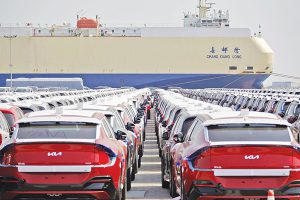Maybe port logjams and semiconductor shortages weren’t such bad problems to have after all.
CEOs have talked of little else for the better part of the past year, but these issues feel rather beside the point compared with the tragic loss of life wrought by Russia’s invasion of Ukraine and have largely dropped out of the headlines. For example, it’s unlikely the average observer noticed 50 ships were waiting to unload outside the twin Ports of Los Angeles and Long Beach, less than half of the 109 vessels that were idling at the peak in January.
The February update for the Federal Reserve Bank of New York’s global supply chain pressure index came out last week and indicated a further easing of conditions. Stanley Black & Decker Inc and Allegion Plc were among the companies that highlighted better access to semiconductors at the Barclays Plc conference in late February. Honeywell International Inc has locked up more than 90% of the chip supply it expects to need this year.
The war in Ukraine has the potential to undo that progress. Honeywell, for example, has used train and truck routes that traverse Russia and Ukraine to ship goods from China to Europe and reduce its dependence on tight markets for air freight and ocean containers, Chief Supply Chain Officer Torsten Pilz said in an interview at the company’s headquarters in Charlotte, North Carolina. Time will tell whether that traffic lane remains an option for the company and others.
Ukraine is also a top producer of the purified neon gas used in advanced chipmaking, introducing a new potential kink in that supply chain. Russia, meanwhile, is a key supplier of palladium, which is used in catalytic converters for cars, and of titanium, which is used in the aerospace industry. Prices for palladium hit a record amid widespread concerns about the impact on commodity supplies from the hostilities and increasingly aggressive economic sanctions in response.
It’s way too early to make definitive predictions about anything.
—Bloomberg
 The Gulf Time Newspaper One of the finest business newspapers in the UAE brought to you by our professional writers and editors.
The Gulf Time Newspaper One of the finest business newspapers in the UAE brought to you by our professional writers and editors.
